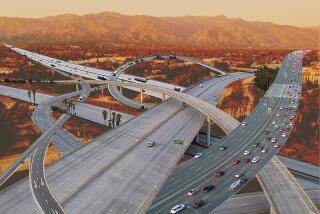Some Commuters Give Close Shave a Whole New Meaning
- Share via
Tell the truth: How many of you have ever shaved, applied makeup or changed your clothes while driving?
If you’ve struggled to put on a clean shirt or shaved your legs while racing down the freeway, you’re not alone.
As dangerous and ludicrous as it may seem, a recent national survey by Farmers Insurance Group found that a surprising percentage of drivers admitted to primping, using cellular phones, changing clothes and reading behind the wheel, despite the obvious risks involved.
Of the 1,004 people surveyed, 665 were drivers, 267 were passengers and 72 commuted by bus, train or other means. Of the drivers, more than 18% of women and 1.3% of men ‘fessed up to applying makeup and 5.6% of both sexes admitted to changing clothes while navigating their vehicles.
But what really catches your attention are the statistics on shaving. About 5.5% of men and 2.1% of women admitted to doing so while driving. Which raises the question: How can anyone manage to shave her legs and keep her eyes on the road?
“That would be hard. You’d have to use cruise control,” quipped California Highway Patrol spokeswoman Wendy Moore.
“Usually, if there’s a police car around, people won’t do that kind of thing,” Moore said. “But I’ve seen men shaving, women putting on makeup, people reading newspapers or magazines while driving.”
Although the Farmers numbers represent a small fraction of drivers--and in some instances are impossible to judge for certain because of the survey’s sampling error of plus or minus 5 percentage points--such behavior is nothing to laugh at.
The National Highway Traffic Safety Administration ranks inattentive driving as the fourth-highest contributing factor in fatal crashes. Nearly 4,000 crashes leading to 4,474 deaths were the result of driver distraction in 1997, the most recent year statistics were available, the agency reports.
Legally, you could shave, brush on mascara or read a book while sitting at a red light or pulled to the side of the road. But if you do so while your vehicle is moving, the CHP or other law enforcement could cite you for driving at an unsafe speed under the circumstances, Moore said.
Preening is not the only risky behavior that survey respondents admitted to, said Kenneth Adams, a spokesman for Farmers, the nation’s third-largest home and auto insurer.
“One out of 10 people on the road admit to reading newspapers or books while driving and 30.6% of those surveyed talk on their cellular phones,” he said.
What about the latest on-board video entertainment systems in vehicles? Relatively new on the market, these potential distractions weren’t covered in the survey. But imagine how scary the roads would be in the future if half the drivers have their vehicles wired with surround-sound video systems and the other half have their car TVs tuned to “Jerry Springer.”
By law, screens must be out of the sight range of drivers. But some vehicle owners have managed to thwart that restriction by repositioning the screens so they can be viewed from the driver’s seat.
Here is what’s really ironic about the Farmers findings: Nearly 90% of those surveyed described themselves as good or excellent drivers. Only 1% admitted to being poor drivers.
That shows that “people really don’t analyze their driving as accurately as they should,” Adams said. “It’s not that you have to be perfect . . . but everyone can improve their driving skills.”
For your own sake and that of others on the road, Farmers offers some tips for safe commuting. Although these may seem self-evident to most of us, the survey results indicate that some drivers could use a reminder:
* Prepare for your day (shaving, makeup, hair and so forth) before leaving for work.
* Remain focused on driving and traffic conditions at all times.
* Don’t drive after drinking alcohol, and avoid medications that may result in drowsiness.
* Get plenty of sleep and allow enough time to get to work on schedule.
Traffic Violations. Our Sept. 2 Your Wheels column erroneously confused traffic misdemeanors and infractions. As two readers, including a former sheriff’s deputy, point out, all one-point violations are classified as infractions, not misdemeanors. The distinction is critical, because infractions are cleared by a fine, whereas misdemeanors can involve a fine or jail time or both and always require a court appearance.
Officer Ernie Sanchez of the California Highway Patrol confirms that running a red light, failing to stop for a stop sign or failing to yield are one-point infractions. Traffic misdemeanors include driving under the influence, reckless driving or speeding in excess of 100 mph.
Jeanne Wright shares the Your Wheels beat with Ralph Vartabedian. She cannot answer mail personally but responds in this column to automotive questions of general interest. Write to Your Wheels, Business Section, Los Angeles Times, Times Mirror Square, Los Angeles, CA 90053. E-mail: [email protected].
More to Read
Sign up for Essential California
The most important California stories and recommendations in your inbox every morning.
You may occasionally receive promotional content from the Los Angeles Times.










